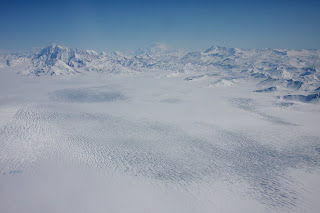
We are just back from Yakutat Glacier, one of the most rapidly retreating glaciers in the world. These icebergs came off the glacier last September and are currently stuck on an old moraine in the lake. The lake is generally very deep (over 300 m), but at this location an old sill keeps icebergs from floating down lake.
 Yakutat Glacier has lost several square kilometers of surface area in the past few years, and no end is in sight. Large rifts are still forming on its floating tongue and further retreat is guaranteed.
Yakutat Glacier has lost several square kilometers of surface area in the past few years, and no end is in sight. Large rifts are still forming on its floating tongue and further retreat is guaranteed.
Last year we measured the ice thickness using an ice penetrating radar, and we found that all of the glacier base is very close to sea level. Harlequin Lake, into which the glacier now calves, will keep growing for quite a while!









